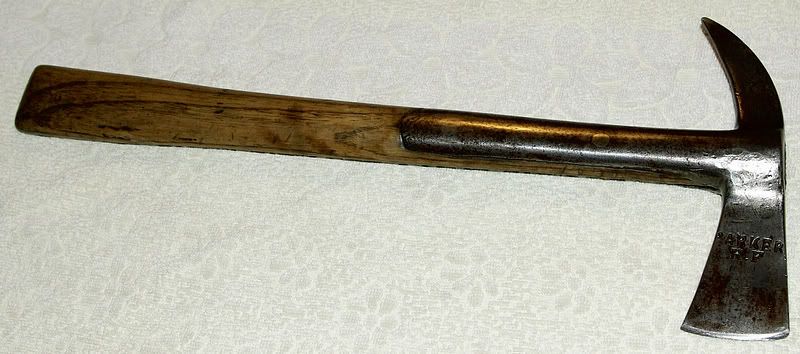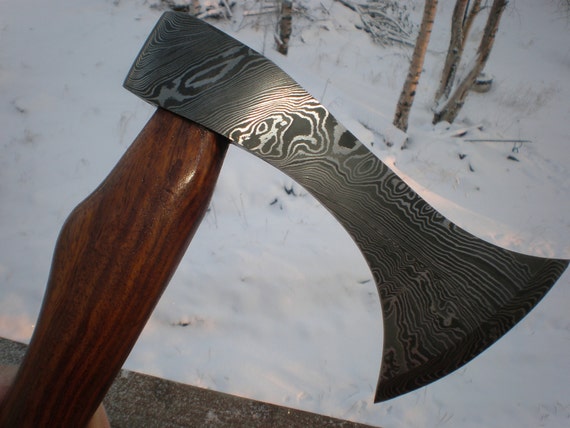
 |
|
|
#1 |
|
Member
Join Date: Jan 2013
Location: Scotland
Posts: 330
|
Hi all, I'm new here but have been reading the posts and learning a lot from them for a few months now.
Can anyone help with this axe. I'm putting it in the European section but I'm not sure whether it has some eastern characteristics. It's no lightweight and the handle is 86cm long. Thanks. |
|
|

|
|
|
#2 |
|
(deceased)
Join Date: Dec 2004
Location: Portugal
Posts: 9,694
|
Hi, welcome to the forum
 Great axe; let's see what the guys in here have to say about it 
|
|
|

|
|
|
#3 |
|
Member
Join Date: Mar 2006
Location: Room 101, Glos. UK
Posts: 4,178
|
looks like a french naval boarding axe. possibly 18th c. they made better looking ones than the english or americans.
 i've always admired them. i've always admired them.a lot of european fire services also use similar axes, some of which have been sold as 'boarding' axes. caveat emptor. note: boarding axes were only secondary as weapons, their primary use was for clearing damaged or burning rigging and woodwork, breaking down barriers, etc. much like a modern spiked fire axe is used for, the spike being useful for hooking and pulling stuff. a similar axe is also used by still existing british cavalry units, a farrier carries a chromed ceremonial spiked axe that was (thankfully no longer) used to put down injured horses (the round straight spike) and to remove the feet (for accounting purposes as proof of death*). i don't think this is one, as they do not have the langets and a farrier's spike straight, not hooked as they are for different purposes. *- 'bean counters' in supply units have been irritating soldiers and sailors since well before the time of agammemnon and the scorpion king. they know the cost of everything and the value of nothing. Last edited by kronckew; 1st February 2013 at 06:40 PM. |
|
|

|
|
|
#4 |
|
Member
Join Date: Dec 2004
Location: NC, U.S.A.
Posts: 2,089
|
Kronckew is dead on with his comments. At first glance, it does very much resemble many of the French boarding types, specifically the m1833 hache de borde, but it would be classified as a 'private purchase' if it is such. That means it would have been made in the style of those used by naval forces, but for merchant ships. Likewise, as my colleague pointed out, many of these type axes still exist as fire implements (which was the final evolution of the boarding ax aboard ships) and tool axes used by infantry units, etc. This one does have a few points going for its possible boarding ax classification-
#1. Its a bearded axe blade, meaning the blade edges curve both up and down. This is an old-style type and not typically seen post-1900, when many of the field axes are seen. #2. The spiked point! If you look at many of the fire axes that evolved from the boarding pieces, their spikes are not of this pattern. This 4-sided point resembles the earlier patterns. At worst, if it is an old fire ax, it truly is OLD! #3. The long haft. When we see the camp axes, Brit fire pieces, military axes, etc, they all ususally have pretty short hafts. The one pictured looks contemporary with the piece, is very long to allow for a good swing in battle, and has a butt that flares, as seen on some boarding pieces. #4. The patina. This is not a late 19th/early 20th c. piece, IMO. It looks genuinely old, pre-1850? Fire axes were just evolving back then and no camp axes resembling this sytle back then. #5. This appears to my weak eyes to be blacksmith-made? Or at least a very early trip-hammer made casting. Even the weak edge to the blade, although making one suspect that it might be ceremonial, could also support a crude boarding weapon, which were contracted weapons with local smiths or one-off patterns that didn't make the cut for naval that firms sold to local merchantmen of the period. #6. Forward and rear-facing langets to secure the head. Yes, we see these on both boarding and fire pieces, but as far as I know, the English pieces had side to side langets and American boarding axes had none. That would make this either a French or Scandinavian pattern, and I am unaware of any existing fire axes resembling this one from those countries. My .02 cents. P.S. Is it for sale??? 
|
|
|

|
|
|
#5 |
|
Member
Join Date: Mar 2006
Location: Room 101, Glos. UK
Posts: 4,178
|
the fore-aft langets are on boarding axes for the practical purpose of protecting the haft from impact with a hard object missed with the blade or spike, ie. a hunk of wood, railing or an opponents weapon in parry. side-to-side ones protect against being cut by an opponent's strike. take your pick.
mini-version, english fireman's axe:   boarding axes: 
|
|
|

|
|
|
#6 |
|
Member
Join Date: Jan 2013
Location: Scotland
Posts: 330
|
Thanks for your input guys.
You make some good points. I think you are right about the blacksmith construction as the lines are a little rudimentary. As for the patina it is fairly even over the whole head but I can't decide whether the wood handle has been coated with something or is just black with age. The only marking is a 6(?) at the base of the handle. Could this be a rack number - which would tend to support the boarding axe? |
|
|

|
|
|
#7 |
|
(deceased)
Join Date: Dec 2004
Location: Portugal
Posts: 9,694
|
Outstanding input Gentlemen,
We sure have in this forum some 'inmates' that can talk a great deal about (boarding) axes. |
|
|

|
|
|
#8 |
|
Member
Join Date: Dec 2004
Location: NC, U.S.A.
Posts: 2,089
|
http://web.prm.ox.ac.uk/weapons/inde...our-europe-154
Note the end shape of the haft compared to our example. |
|
|

|
|
|
#9 |
|
Member
Join Date: Mar 2006
Location: Room 101, Glos. UK
Posts: 4,178
|
the side langets are an english affectation.
 i suspect the axe posted by mr. eley is an english copy of a french one. the std. english broad arrow ones tended to being more angular, wedge-like with straighter lines and a straighter edge. they, generally had a ball ended haft too. i suspect the axe posted by mr. eley is an english copy of a french one. the std. english broad arrow ones tended to being more angular, wedge-like with straighter lines and a straighter edge. they, generally had a ball ended haft too.early 19th c. royal navy pattern (nelsonian)  french boarding axe:  note the fore-aft rather than side langets, and the haft end is more pry-like. just to complexicate things, american fire axe presented after the great fire in hoboken, NJ (1900)  note the lack of langets. my everyday axe just for drool factor  
Last edited by kronckew; 2nd February 2013 at 04:45 PM. |
|
|

|
|
|
#10 |
|
Member
Join Date: Jan 2013
Location: Scotland
Posts: 330
|
Excellent pictures Kronckew and I think I agree with you that the French have the edge when it comes to the elegance factor.
I know it's not a hundred percent conclusive but until anyone says different, it's in my collection as an early 19th century (possibly)French boarding axe. Many thanks to you both. |
|
|

|
|
|
#11 |
|
Member
Join Date: Dec 2004
Location: NC, U.S.A.
Posts: 2,089
|
You are a lucky man! I love your ax. I, unfortunately, only have one true boarding ax in my collection and have been wanting one of these French types. Forgot to mention that the eye on yours is squared, another popularity with the French patterns.
Thank you, Kronckew, for posting the pics. I'm not so savvy when it comes to such things-  . Yes, I did notice that the one I mentioned was British, but of the French pattern. Forgot to mention that and hope it didn't cause any confusion. It is interesting that the boarding axe, serving as both a weapon and tool, became the standard fire ax as we know it. It goes back to the fact that on the crowded decks of ships, almost anything could become a weapon in a hand-to-hand melee (whaling blubber knives, belaying pins, axes, rope and tackle, rumlets, grappling hooks, etc, etc). The trick is deciding when is an ax a weapon and when is it just a fire suppressant? . Yes, I did notice that the one I mentioned was British, but of the French pattern. Forgot to mention that and hope it didn't cause any confusion. It is interesting that the boarding axe, serving as both a weapon and tool, became the standard fire ax as we know it. It goes back to the fact that on the crowded decks of ships, almost anything could become a weapon in a hand-to-hand melee (whaling blubber knives, belaying pins, axes, rope and tackle, rumlets, grappling hooks, etc, etc). The trick is deciding when is an ax a weapon and when is it just a fire suppressant?
|
|
|

|
|
|
#12 | |
|
Member
Join Date: Mar 2006
Location: Room 101, Glos. UK
Posts: 4,178
|
Quote:
that went out of fashion as the fire activity predominated. and boarding actions became rare. sadly, with attacks on responding fireman increasing, it may see use as a weapon again. even boarding activity at sea is on the increase. pirates might get a surprise! they're already using firehoses to wash them off ladders... |
|
|
|

|
 |
|
|